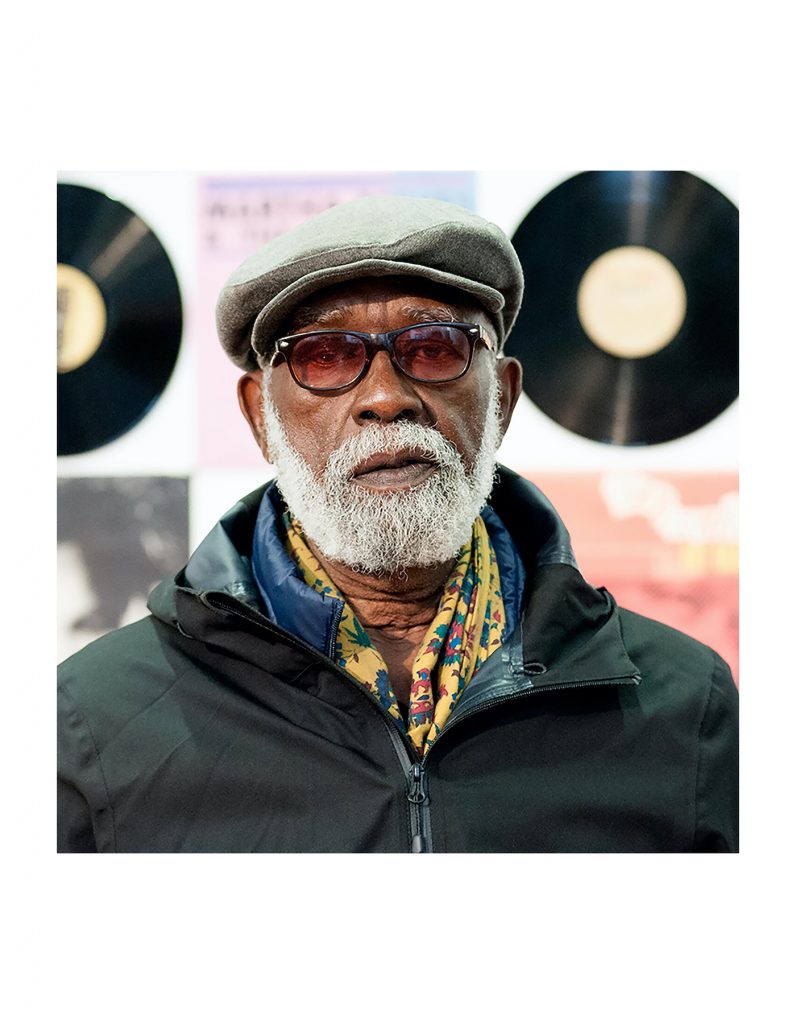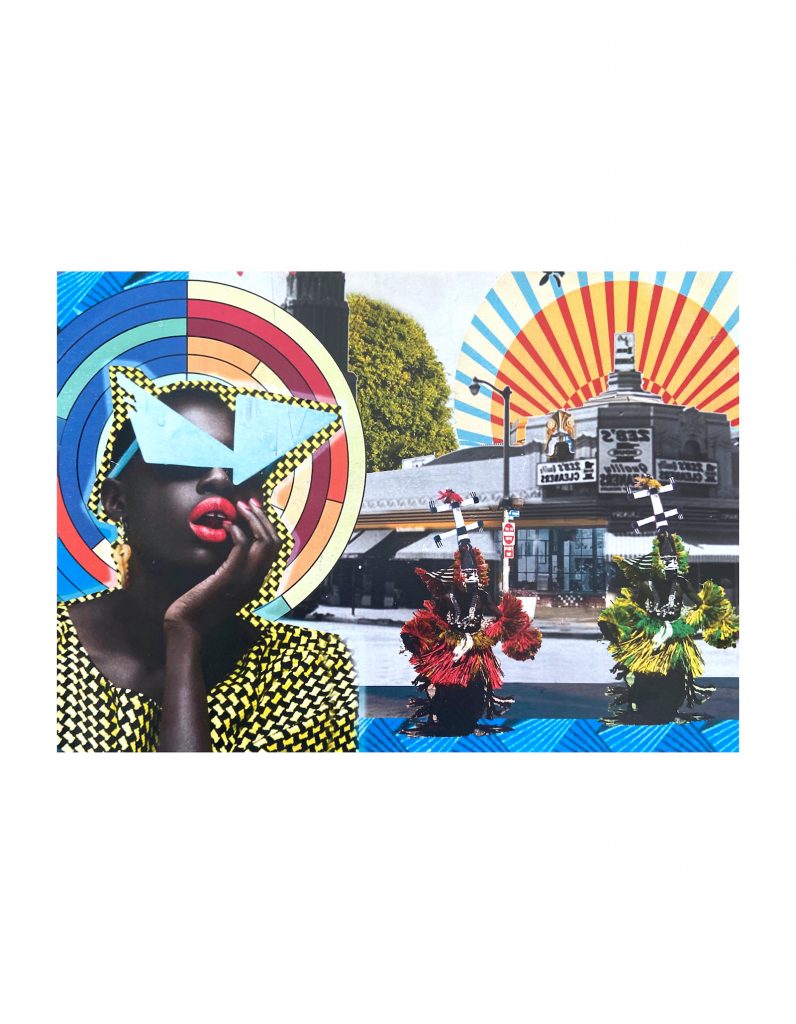
If you’re lucky, certain people you encounter in life are destined to become cardinal points on your personal map. Dependable, open-hearted folks you meet by chance and who continue to illuminate and inspire you even as time speeds past.
The artist Ben Caldwell has long filled that role for me.
More years ago than seems possible, I had my first conversation with Caldwell. I was working as a young reporter for one of Los Angeles’ scrappy alternative newspapers, writing about the L.A. that wasn’t on postcards. Nevertheless, it was a Los Angeles that was vital, vivid and worth the time to get to know. Back then, Caldwell’s storefront in Leimert Park Village, Video 3333, was a creative epicenter for youth in South L.A. and beyond. In 1990, he moved operations just steps away to 4343 Leimert Blvd. and renamed the space KAOS Network.
KAOS, just like Video 3333, was a safe haven for kids and young adults who were in need of a place to stretch their sense of themselves, to test their own creative skills outside of a teacher’s or parent’s eye. Peer to peer, it was also a place of healing, particularly for youth of color who needed a refuge to be heard and nurtured on a deeper level.

One morning, I stepped across the threshold of Caldwell’s early space on Degnan Boulevard to interview him about his friend and fellow filmmaker Charles Burnett’s much-anticipated release “To Sleep With Anger.” Once we’d covered the necessary context and background questions I’d prepared, I turned my recorder off and stashed my notebook away — but Caldwell and I kept talking. As we chatted, I watched kids wander into a small open space with a tiny stage. Some had a specific task to attend to; others just peeked in to say hello. Video screens flickered above us and speakers were turned up just enough to allow our own words to bounce on a flow of beats. The energy in Caldwell’s studio was fresh, kinetic. And he was less monitor than mentor, a co-conspirator. His enthusiasm — genuine. That wink let you know: Keep going. The path is yours to define.
While I was well out of his target audience’s range, I will always remember what it felt like to be in that workshop for the first time. I was itching to pick up a video camera, a paintbrush, or lean over a DJ’s deck. I wanted to venture deep into my own uncharted imagination.
L.A. youth still wander in to sit front row and take advantage of what’s available just on the other side of the threshold. Caldwell’s ear is tuned to their imagination; he still generously offers that sun-like smile. Leimert Park Village has, for decades, been home to Black creatives of various disciplines — poets, painters, musicians, filmmakers, jewelry makers, curators and beyond. And even more for Black Angelenos, who live and work and thrive in those zip codes, and yet still with few public spaces to call our very own, “The Village” has been a place to celebrate our culture and its richness, a place to find and build family.
Getting young people to think beyond limitations
If there was a way to bottle this sort of heady inspiration — what it’s like to move through Caldwell’s signature workspaces, as well as his busy mind — the closest you might get is the recently published book — a kind of museum and art gallery, really — “KAOS Theory: The AfroKosmic Ark of Ben Caldwell.” Written by Robeson Taj Frazier with Caldwell’s close eye and input, the book chronicles not just Caldwell’s personal story, but those of his forebears — blood relatives and kinship circles — reaching back beyond his New Mexico youth to his family’s roots and branches. It, as well, explores the adjacent histories of the communities that he’s intersected with over the decades. For as long as I’ve known him, he has wanted to be out of the spotlight, to tilt the beam toward the community, and, in this way, this book is a testament to what’s possible if you make your life’s creative work a community you tend to daily.
Caldwell is a location in and of himself. He also brings his own atmosphere, time and tempo. As Frazier writes in the book’s preface: “He demonstrates appreciation for the weight and texture of each word and value of both word and breath. There is an acknowledgement of the power of pauses, breaks, intonation and exhalations.” Accordingly, Frazier, an associate professor of communications at the University of Southern California, stepped into Caldwell’s rhythms and took his lead, earning Caldwell’s confidence, ultimately convincing him to tell his far-reaching story, one that takes us deep into his creative pathways.
“People have given Ben many titles, filmmaker, artist, technologist, activist,” writes Frazier, “He is a polymath that a journalist once described as the octopus of Leimert Park.” Caldwell has also understood the importance of “disruption” long before it became a tech world buzzword. Hence, “KAOS,” writes Frazier, is the “dynamic and divergent cycles of coexistence, healing and emergence that are ever present in…life.”
What animates the text is the generous treasure of archival images — Caldwell’s artwork — his photographs and mixed-media work, event fliers and newspaper clippings and scrapbook snapshots stretching across time and place, all this set alongside his poetic philosophizing. Its pages feature bright colors and busy fonts that seem to jump and shimmer on the page, making them feel almost 3D, mimicking the buzzy energy of being in his presence, eyeing the doorway to see who might bedrifting by for a cameo.
Funded by teaching grants and a calendar of commercial productions and events, Caldwell’s grassroots enterprise, writes Frazier, “is an axis for innovative creative expression and technological creativity.” Within these walls, Caldwell encourages experimentation, taking leaps, blending genres and disciplines. He wants young people to think beyond the narrow categories presented to them. Out of this incubator has come cutting-edge workshops, performances and residencies, most famously Project Blowed — an open-mic workshop, which featured West Coast alternative hip hop acts including Freestyle Fellowship and, more recently, an ad hoc monthly DJ and hip hop meetup, Bananas, where the singer and rapper, Amala Ratna Zandile Dlamini, an L.A. native, now known as the Grammy Award-winning artist Doja Cat, took the stage as a teenager, back in 2014, still trying out versions of herself. She found both community and courage in “The Village.”
Artists as neighborhood pillars
Engagingly nonlinear and dotted with side paths, much like an open-ended conversation with Caldwell, “KAOS Theory” drops you into the thick of what it means to dedicate yourself to something community-built in nature — the “ark” referenced in the title. That “ark” is a nod to a concept adopted long ago by Black artists and activists to describe their relationship to their greater kinship circle: “People stretch themselves and their imagination and their relationship with other humans and forms of life and in so doing, new possibilities … of co-existing and loving are revealed,” writes Frazier. “This is what we refer to as an ark, the emergent strategies of endurance and imagination and love that are central to our lives.”
It’s safe to say this document would not be a Ben Caldwell “production” without the inclusion of many voices — ghosts and echoes and ongoing conversations that Caldwell carries about with him on the day to day. For Angelenos who have even brushed up briefly against KAOS Network or know someone who has come through, this book will feel like a block-party-scale reunion, a lively portable archive. It’s a testament to his staying power and depth of commitment.
This brings to mind an image I carry close. Caldwell told me early on, amid our many conversations, that he chose Leimert Park as a cardinal point, because of how centrally located it is in L.A. — an outsized city without a classic “center.” It was adjacent to a web of bus lines and sat nearby the former pathways of the old streetcar lines, which have now evolved into the footprint of new Metro lines. He was visible and reachable. Then, like now, I’d watch those kids paddle up on their bikes or balanced on skateboards, making sure they weren’t missing anything.
To this day, I can’t travel through Leimert Park without checking to see if Caldwell’s door is open, or slow down if I think I might see him standing on the sidewalk. In his mind, it’s precisely this symbol — that of steadiness and possibility. “Artists should have the same role in the community as doctors or lawyers,” he asserts. “They should be there on the street. You should be able to drop in and interact with them.”
His very presence is a pledge — not just modeling, but embodying. He’s made dreams tangible. His life’s arc points to an alternative way to move through landscape, and leave an indelible mark, as a both visionary and connector — particularly for youth of color. What Caldwell’s fortitude telegraphs is that you shouldn’t need to travel out of the community to find your passion, your very self. That possibility should be part of the warp and weave of daily life. It’s right here, around the corner, waiting for you.
Lynell George is a Grammy Award-winning author and journalist based in L.A. A former staff writer for The Los Angeles Times and L.A. Weekly, she is author of three books, including “A Handful of Earth, A Handful of Sky: The World of Octavia E. Butler.”
































